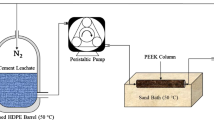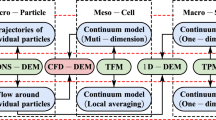Abstract
Injection of CO2 into gas reservoirs for CO2-enhanced gas recovery will initiate a series of geochemical reactions between pore fluids and solid phases. To simulate these conditions, the coupled multiphase flow and multicomponent reactive transport simulator OpenGeoSys-ChemApp was extended to take into account the kinetic nature of fluid/mineral reactions. The coupled simulator is verified successfully for the correctness and accuracy of the implemented kinetic reactions using benchmark simulations. Based on a representative geochemical model developed for the Altensalzwedel compartment of the Altmark gas field in northeastern Germany (De Lucia et al. this issue), the code is applied to study reactive transport following an injection of CO2, including dissolution and precipitation kinetics of mineral reactions and the resulting porosity changes. Results from batch simulations show that injection-induced kinetic reactions proceed for more than 10,000 years. Relevant reactions predicted by the model comprise the dissolution of illite, precipitation of secondary clays, kaolinite and montmorillonite, and the mineral trapping of CO2 as calcite, which starts precipitating in notable quantities after approximately 2,000 years. At earlier times, the model predicts only small changes in the mineral composition and aqueous component concentrations. Monitoring by brine sampling during the injection or early post-injection period therefore would probably not be indicative of the geochemical trapping mechanisms. One-dimensional simulations of CO2 diffusing into stagnant brine show only a small influence of the transport of dissolved components at early times. Therefore, in the long term, the system can be approximated reasonably well by kinetic batch modelling.








Similar content being viewed by others
References
Audigane P, Gaus I, Czernichowski-Lauriol I, Pruess K, Xu T (2007) Two-dimensional reactive transport modeling of CO2 injection in a saline aquifer at the Sleipner site, North Sea. Am J Sci 307:974–1008
Bachu S, Gunter WE, Perkins EH (1994) Aquifer disposal of CO2: Hydrodynamic and mineral trapping. Energy Convers Manag 35:69–279
Bauer S, Beyer C, Kolditz O (2006) Assessing measurement uncertainty of first-order degradation rates in heterogeneous aquifers. Water Resour Res 42:W01420. doi:10.1029/2004WR003878
Bear J, Bachmat Y (1990) Introduction to modeling of transport phenomena in porous media. Kluwer Academic Publishers, Dordrecht
Beyer C, Bauer S, Kolditz O (2006) Uncertainty assessment of contaminant plume length estimates in heterogeneous aquifers. J Contam Hydrol 87:73–95
Beyer C, Konrad W, Rügner H, Bauer S, Liedl R, Grathwohl P (2009) Model based prediction of long-term leaching of contaminants from secondary materials in road constructions and noise protection dams. Waste Manag 29:839–850
Böttcher N, Singh AK, Kolditz O, Liedl R (2011) Non-isothermal, compressible gas flow for the simulation of an enhanced gas recovery application. J Comput Appl Math (published online). doi:10.1016/j.cam.2011.11.013
Brantley S, Kubicki J, White AF (2008) Kinetics of water–rock interaction. Springer, New York
Cash JR, Karp AH (1990) A variable order Runge–Kutta method for initial value problems with rapidly varying right-hand sides. ACM Transact Math Softw 16:201–222
De Lucia M, Bauer S, Beyer C, Kühn M, Nowak T, Pudlo D, Reitenbach V, Stadler S. Modelling CO2-induced fluid–rock interactions in the Altensalzwedel gas reservoir. Part I: from experimental data to a reference geochemical model. Environ Earth Sci (this issue)
Dethlefsen F, Haase C, Ebert M, Dahmke A (2012) Uncertainties of geochemical modeling during CO2 sequestration applying batch equilibrium calculations. Environ Earth Sci 65:1105–1117
Duan Z, Sun R (2003) An improved model calculating CO2 solubility in pure water and aqueous NaCl solutions from 273 to 533 K and from 0 to 2000 bar. Chem Geol 193:253–271
Engesgaard P, Kipp KL (1992) A geochemical transport model for redox-controlled movement of mineral fronts in groundwater flow systems: a case of nitrate removal by oxidation of pyrite. Water Resour Res 28:2829–2843. doi:10.1029/92WR01264
Fredd CN, Fogler HS (1998) Influence of transport and reaction on wormhole formation in porous media. AIChE J 44:1933–1949
Graupner B, Li D, Bauer S (2011) The coupled simulator ECLIPSE–OpenGeoSys for the simulation of CO2 storage in saline formations. Energy Procedia 4:3794–3800
Köhler SJ, Dufaud F, Oelkers EO (2003) An experimental study of illite dissolution kinetics as a function of pH from 1.4 to 12.4 and temperature from 5 to 50 °C. Geochim Cosmochim Acta 67:3583–3594
Kolditz O, Bauer S (2004) A process-oriented approach to computing multi-field problems in porous media. J Hydroinformatics 6:225–244
Kolditz O, Shao H (2009) Developer Benchmark Book on THMC Components of Numerical Codes GeoSys/Rockflow V. 4.9. Helmholtz Centre for Environmental Research (UFZ), Leipzig
Kolditz O, Bauer S, Bilke L, Böttcher N, Delfs JO, Fischer T, Görke UJ, Kalbacher T, Kosakowski G, McDermott CI et al (2012) OpenGeoSys: an open-source initiative for numerical simulation of thermo-hydro-mechanical/chemical (THM/C) processes in porous media. Environ Earth Sci (published online). doi:10.1007/s12665-012-1546-x
Kolditz O, Bauer S, Beyer C, Böttcher N, Dietrich P, Görke UJ, Kalbacher T, Park CH, Sauer U, Schütze C, Singh A, Taron J, Wang W, Watanabe N. Technical paper: a systematic for CO2 benchmarking. Environ Earth Sci (this issue). doi:10.1007/s12665-012-1656-5
Kühn M, Förster A, Großmann J, Meyer R, Reinick K, Schäfer D, Wendel H (2011) CLEAN: preparing for a CO2-based enhanced gas recovery in a depleted gas field in Germany. Energy Procedia 4:5520–5526
Kühn M, et al. CLEAN: CO2 large-scale enhanced gas recovery in the Altmark natural gas field (Germany): project overview. Environ Earth Sci (this issue)
Lagneau V, van der Lee J (2010) Operator-splitting-based reactive transport models in strong feedback of porosity change: The contribution of analytical solutions for accuracy validation and estimator improvement. J Contam Hydrol 112:118–129
Lasaga AC (1995) Fundamental approaches in describing mineral dissolution and precipitation rates. In: White AF, Brantley SL (eds) Chemical weathering rates of silicates minerals—reviews in mineralogy, vol 31. BookCrafters, Chelsea
Lasaga AC, Soler JM, Ganor J, Burch TE, Nagy KL (1994) Chemical weathering rate laws and global geochemical cycles. Geochim Cosmochim Acta 58:2361–2386
Li D, Bauer S (2009) Development of a coupled transport and geochemical reaction code and a first application to CO2 sequestration. In: Huber F, Lützenkirchen J, Pfingsten W, Tiffreau C (eds) Proceedings of the Workshop TRePro II. 18.-19.5.2009, Forschungszentrum Karlsruhe in der Helmholtz-Gemeinschaft, Wissenschaftliche Berichte FZKA 7482
Li D, Graupner B, Bauer S (2011) A method for calculating the liquid density for the CO2–H2O–NaCl system under CO2 storage condition. Energy Procedia 4:3817–3824
Moog HC, Mönig H (2010) Erstellung von Parameterdateien für die Verwendung mit CHEMAPP und PHREEQC. Final Report to BGR project 45-4500046190, GRS, Braunschweig
Palandri JL, Kharaka YK (2004) A compilation of rate parameters of water–mineral interaction kinetics for application to geochemical modelling. US Geol Survey Water-Resources Investigations Report 04-1068
Park CH, Beyer C, Bauer S, Kolditz O (2008) Using global node-based velocity in random walk particle tracking in variably saturated porous media: application to contaminant leaching from road constructions. Env Geol 55:1755–1766
Petersen S, Hack K (2007) The thermochemistry library ChemApp and its applications. Int J Mat Res 98(10):935–945
Pudlo D, Reitenbach V, Albrecht D, Ganzer L, Ulrich G, Wienand J, Kohlhepp B, Gaupp R. The impact of diagenetic fluid–rock reactions on Rotliegend sandstone composition and petrophysical properties (Altmark area, central Germany). Environ Earth Sci (this issue)
Rozalen M, Huertas FJ, Brady PV (2009) Experimental study of the effect of pH and temperature on the kinetics of montmorillonite dissolution. Geochim Cosmochim Acta 73:3752–3766
Shao HB, Dmytrieva SV, Kolditz O, Kulik DA, Pfingsten W, Kosakowski G (2009) Modeling reactive transport in non-ideal aqueous-solid solution system. Appl Geochem 24:1287–1300
Steefel CI, Lasaga AC (1994) A coupled model for transport of multiple chemical species and kinetic precipitation/dissolution reactions with application to reactive flow in single phase hydrothermal systems. Am J Sci 294:529–592
Szymczak P, Ladd AJC (2011) Instabilities in the dissolution of a porous matrix. Geophys Res Lett 38:L07403. doi:10.1029/2011GL046720
Wang W, Kolditz O (2007) Object-oriented finite element analysis of thermo-hydro-mechanical (THM) problems in porous media. Int J Numer Methods Eng 69:162–201
Xie M, Bauer S, Kolditz O, Nowak T, Shao H (2006) Non-isothermal multi-component reactive transport in partially saturated porous media: Application to bentonite. J Contam Hydrol 83:122–147
Xu T, Apps JA, Pruess K (2004) Numerical simulation of CO2 disposal by mineral trapping in deep aquifers. Appl Geochem 19:917–936
Xu T, Apps JA, Pruess K (2005) Mineral sequestration of carbon dioxide in a sandstone–shale system. Chem Geol 217:295–318
Xu T, Apps JA, Pruess K, Yamamoto H (2007) Numerical modeling of injection and mineral trapping of CO2 with H2S and SO2 in a sandstone formation. Chem Geol 242:319–346
Xu T, Kharaka YK, Doughty C, Freifeld BM, Daley TM (2010) Reactive transport modeling to study changes in water chemistry induced by CO2 injection at the Frio-I Brine Pilot. Chem Geol 271:153–164
Zerai B, Saylor BZ, Matisoff G (2006) Computer simulation of CO2 trapped through mineral precipitation in the Rose Run Sandstone, Ohio. Appl Geochem 21:223–240
Acknowledgments
This work is part of the joint R&D project CLEAN, sponsored by the German Federal Ministry of Education and Research (BMBF) within the framework of the “GEOTECHNOLOGIEN” program (publication number GEOTECH-1993). We gratefully acknowledge the funding of our work by the BMBF (grants 03G0704 J (CAU) and 03G0704A (GFZ)). Furthermore, we would like to thank GDF Suez E&P Deutschland GmbH for research collaboration and the CLEAN project coordination and management. Last, but not least, we are grateful to the two anonymous referees for their constructive comments and suggestions made during the review process.
Author information
Authors and Affiliations
Corresponding author
Rights and permissions
About this article
Cite this article
Beyer, C., Li, D., De Lucia, M. et al. Modelling CO2-induced fluid–rock interactions in the Altensalzwedel gas reservoir. Part II: coupled reactive transport simulation. Environ Earth Sci 67, 573–588 (2012). https://doi.org/10.1007/s12665-012-1684-1
Received:
Accepted:
Published:
Issue Date:
DOI: https://doi.org/10.1007/s12665-012-1684-1




